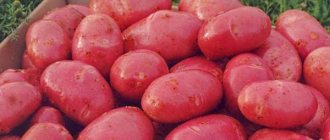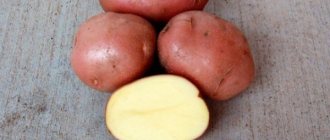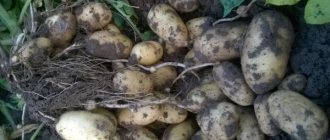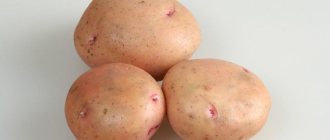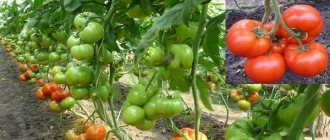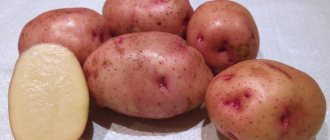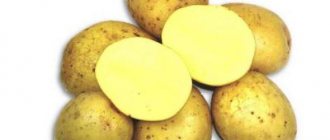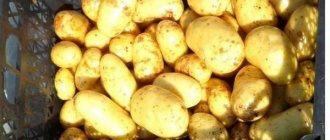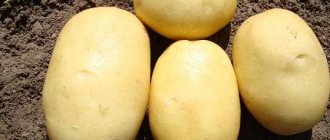Vegetable growing » Potatoes
0
1523
Article rating
Kira Stoletova
The Moscow region is often called a place where any planting of vegetable and fruit crops does not bring the expected yield. Meanwhile, there are a number of potato varieties that fit perfectly even in these conditions, so you can safely plant them and hope for a good harvest. Thanks to breeders, today there are potato varieties for the Moscow region that have their own characteristics and fully comply with the above-mentioned requirements. How to choose the best?
Popular potato varieties for the Moscow region
The most delicious varieties
Tuleevsky
A mid-season table variety that produces a rich harvest with good taste. Tubers ripen in 90-111 days.
Interesting! It received its name in honor of Aman Tuleyev, the former governor of the Kemerovo region.
It does not like chemical fertilizing and watering, so only humus can be used for fertilizer. If there is a lack of boron in the soil, voids appear inside the fruit.
Recommended for preparing any dishes, but it is best to prepare puree. It cooks medium well and does not darken during processing.
Characteristic:
- Medium ripening (90-111 days).
- Shape: elongated, oval.
- The peel is yellow and rough.
- The pulp is yellow.
- Starch – 15-17%.
- Productivity – 180-425 kg per hundred square meters.
- The average tuber weight is 120-270 g,
- There are 8-10 tubers on one bush.
- Not susceptible to potato cancer.
- Has average damage to nematodes and late blight.
- Well preserved during transportation.
How and how to fertilize potatoes in the spring, when planting in a hole, in summer and autumn, rules for preparing a potato bed
Picasso
A late table variety that produces a rich harvest of fruits with normal taste. Tubers ripen in 120-140 days. Resistant to drought and heat.
Interesting! It got its name in honor of the artist because of the yellow-pink color of its skin. In Russia people call him Limonka.
Recommended for preparing salads and frying. Does not boil over and does not darken during processing. Used for frying and French fries, salads and soups.
Characteristic:
- Late ripening (120-138 days).
- The shape is oval.
- The peel is yellow with pink eyes.
- The pulp is creamy.
- Starch – 7-13%.
- Productivity - 190-310 kg per hundred square meters.
- The average weight of a tuber is 75-125 g, there are 19 tubers in 1 bush.
- Not susceptible to potato cancer and nematode.
- Susceptible to late blight and scab.
- Well preserved during transportation.
- Good keeping quality.
Adretta
Mid-early (tubers ripen in 83-90 days), a table variety that produces a rich harvest of fruits with excellent taste. Brings a stable harvest and quickly forms tubers in any weather.
Recommended for preparing various dishes.
Characteristic:
- Mid-early ripening period (83-90 days).
- The shape is oval.
- The peel is yellow.
- The pulp is yellow.
- Starch – 13-18%.
- Productivity - 400-450 kg per hundred square meters.
- The average weight of a tuber is 100-150 g.
- About 15-25 tubers grow on one bush.
- Not susceptible to potato cancer, nematode, late blight.
- Good keeping quality.
Features of the climate of the Moscow region
The Moscow region is a region with a temperate continental climate with mild winters and not too hot summers. The seasons are clearly separated here. Around mid-March, spring arrives with bright sunshine and thaw. In the first half of April, the snow has completely melted, positive air temperatures have set in and the soil begins to warm up. On the twentieth of April, the farming season opens.
Potatoes are usually planted in early May. As a rule, the date is chosen according to the recommendations of the lunar calendar and weather conditions. The main thing is that at a depth of 10 cm the soil must be heated to at least 9°C. Untimely sowing will reduce the yield by at least a third. And given the unpredictable weather in the Moscow region, the entire harvest could be at risk.
Even the right planting time will not give a good potato harvest if you choose the wrong variety. In the Moscow region, half of all annual precipitation falls in the summer. Here every 2nd day there are rains and thunderstorms, constant cloudiness. Because of this, only a third of sunlight and heat are consumed. Potatoes are affected by various diseases from excess air and soil moisture, so it is best to grow zoned varieties.
Planting potatoes
Potatoes in the Moscow region are planted from the end of April to the end of May, depending on the rate of soil warming. The main condition is that the soil at a depth of 10 cm is heated to at least 9°C.
Classic methods of planting potatoes
There are three classic methods of planting potatoes: smooth, trench, ridge. An assessment of the climate and soil composition will help you choose the right one.
Trench
Suitable for warm climates, light and sandy soil that does not contain moisture. Tubers are laid out in trenches 10–15 cm deep, located at a distance of 70 cm from each other. 30–40 cm are left between the tubers in the trench itself. This method is the most undesirable for the humid climate of the Moscow region. Very often, gardeners are left completely without a harvest because the potatoes rot in the trenches.
Smooth
Holes are dug at a distance of 60–70 cm from each other with a depth of about 15 cm. Ash, onion or garlic peels are placed at the bottom. Sprouted tubers are placed in them and sprinkled with earth on top.
Comb
On heavy, waterlogged soil, this method is suitable. Ridges 10–15 cm high are made at a distance of 70 cm from each other, into which tubers are planted at a distance of 30 cm from each other. This will help get rid of excess moisture.
Classic potato planting provides tubers with optimal conditions for formation and growth, and also eliminates pests
Alternative ways to plant potatoes
To obtain the desired harvest, gardeners use various options for planting potatoes. There are many methods invented experimentally by amateur and professional gardeners.
Surgutanov method
Its essence is that there is no need to dig holes - the tubers are placed directly on the ground, covered with soil from the passages and covered with film until mid-June. This way, you can plant potatoes earlier without waiting for the soil to warm up. This method not only enhances stem growth, but also retains moisture in the soil. On sunny days, the film needs to be removed, weeded, loosened and watered, and covered again in the evening.
According to N. Surgutanov’s method, the harvest can be harvested 2 weeks ahead of schedule.
Dutch method of planting potatoes
The Dutch method works well, in which special attention is paid to air exchange of the roots. Potatoes are planted on a flat area according to a 60*30 cm pattern. When hilling, the plants are sprinkled with soil from the rows, forming high ridges with a base width of 30–35 cm.
The Dutch method saturates plant roots with air
Growing under straw or hay
Potatoes can be grown under straw in two ways. Firstly, dig a hole, put a tuber, sprinkle with earth, cover the top with a layer of straw of 15–20 cm. Secondly, put the tubers directly on the ground, sprinkle with earth, cover with straw or hay on top with a layer of 30–50 cm.
The advantages of this method:
- absence of weeds that simply cannot break through the straw;
- rotting straw is an excellent habitat for worms, which are very beneficial for the soil;
- the potatoes are warm in the straw;
- The Colorado potato beetle bypasses, or rather flies around, such potatoes.
If you decide to skimp on straw and cover the potatoes poorly, they will turn green and become completely unusable.
Video: harvesting crops grown under hay
Planting potatoes in a box
Burlap or film is placed on the ground, a blank with supports under a wooden box is placed on top, soil is poured, and the tubers are buried in it. As the tops grow, soil is added. Crossbars are added to the sides until the plant reaches 1.2–1.3 m in height.
Potatoes in a box in the Moscow region ripen by mid-September, but you can give them until the beginning of October if the weather permits
After about two months from the moment of sowing, the stems will dry out and turn yellow, and the tubers will ripen. To facilitate the process of collecting potatoes, one side of the box is disassembled. This method requires abundant watering of the plants.
Potatoes in a box need plenty of watering
Growing potatoes in a bag
If the area of your plot is very small and there is absolutely no room for potatoes, plant them in bags. Pour mixed soil and humus into them (in a 1:1 ratio), and lay the tubers. As the tops sprout, add soil. This method will minimize labor costs, and harvesting will consist of shaking out the contents of the bag and collecting the tubers. During periods of prolonged rain and cold weather, the bags can be moved to a protected place.
As planting containers, you can use either special bags with valves for sampling tubers, or regular flour or sugar containers.
How to grow potatoes in a barrel
Soil and compost are poured into a barrel without a bottom in a layer of 15 cm, tubers are laid out and sprinkled with soil on top. As the tops grow, soil is added until the barrel is full. Harvesting using this method is also very simple: the barrel is turned over and the tubers are selected. The convenience is that the barrel can be covered from rain and cold weather.
Video: methods of potato agricultural technology
Methods of growing potatoes in the Moscow region
Greenhouses and greenhouses help protect potatoes from negative environmental factors. A greenhouse is a frame film shelter that saves plants from cold weather and creates optimal conditions for their growth and development. With its help, the harvest can be obtained as early as late May - early June. To prevent excess moisture from accumulating in the greenhouse, it must be periodically opened for ventilation.
To reduce growing costs and make room for other crops, mostly early-ripening varieties (super-early and early) are planted in greenhouses.
Greenhouses are used to produce early and super-early potatoes. When the soil warms up to 5–7°C, the sprouted tubers are planted in holes 8 cm deep, according to a 70x25 cm pattern. Before planting, the soil must be fertilized and dug up. Air humidity for plants should be at least 80–100%. The temperature during growth, budding and flowering is maintained at about 23°C, with mass formation of tubers at 19°C. In a greenhouse, the harvest is obtained two weeks earlier than in open ground. It protects potatoes from adverse weather conditions, diseases and the Colorado potato beetle.
The greenhouse will protect potatoes from bad weather, diseases and pests
Where and when is it formed?
The causative agent of scab is in the soil, so it is not always possible to completely destroy it. The bacteria mainly overwinter in fallen leaves, and the peak of the disease worsens in the spring, when it becomes warm and humid outside.
Also, for the successful development of such a disease, certain parameters are important:
- air temperature +25-30°C;
- sandy, loose, dry soil;
- the presence of a large amount of organic fertilizers in the soil, in particular humus;
- alkaline earth;
- lack of manganese and boron in the soil, and an excess of calcium and nitrogen;
- air humidity not less than 70%;
- lack of immunity in the root crop to this disease.
Principles of protection and struggle
However, the positive point in this situation is the fact that scab can and should be fought . To do this, a whole range of measures must be planned for the treatment of root crops.
How to get rid of it?
- For planting, choose a variety that is resistant to scab and suitable for the conditions of your region.
- Before planting, tubers should be carefully examined; sick ones should not be planted.
- Store potatoes in a cool, dry place.
- Poison root seeds with strong chemicals. For example, Maxim, Fitosporin, Polycarbocin.
- Try to change where you plant potatoes. After all, pathogenic microorganisms can live in one place for up to 5 years.
- Do not plant potatoes in a bed where carrots and beets grew, because they also suffer from this disease.
- After entry and during flowering, treat the bushes with growth stimulants Epin and Zircon.
- Fresh manure should not be added to the soil before planting.
How to treat the earth?
After harvesting the potatoes, in the fall the beds should be planted with green manure, for which it is better to use mustard, legumes or cereals.
They are natural antiseptics and disinfectants, prevent the proliferation of pathogenic fungi, and protect crops from attack by harmful insects.
When the synderata grow by about 20 cm, the area is dug up, mixing the sprouts with soil. In spring, you can sprinkle mustard powder on the soil.
Because scab develops well in alkaline soils with a lack of manganese and boron. Therefore, it is recommended to add the following types of mineral fertilizers to the soil in spring:
- ammonium sulfate;
- superphosphate;
- potassium magnesia;
- copper sulfate;
- manganese sulfate;
- boric acid.
